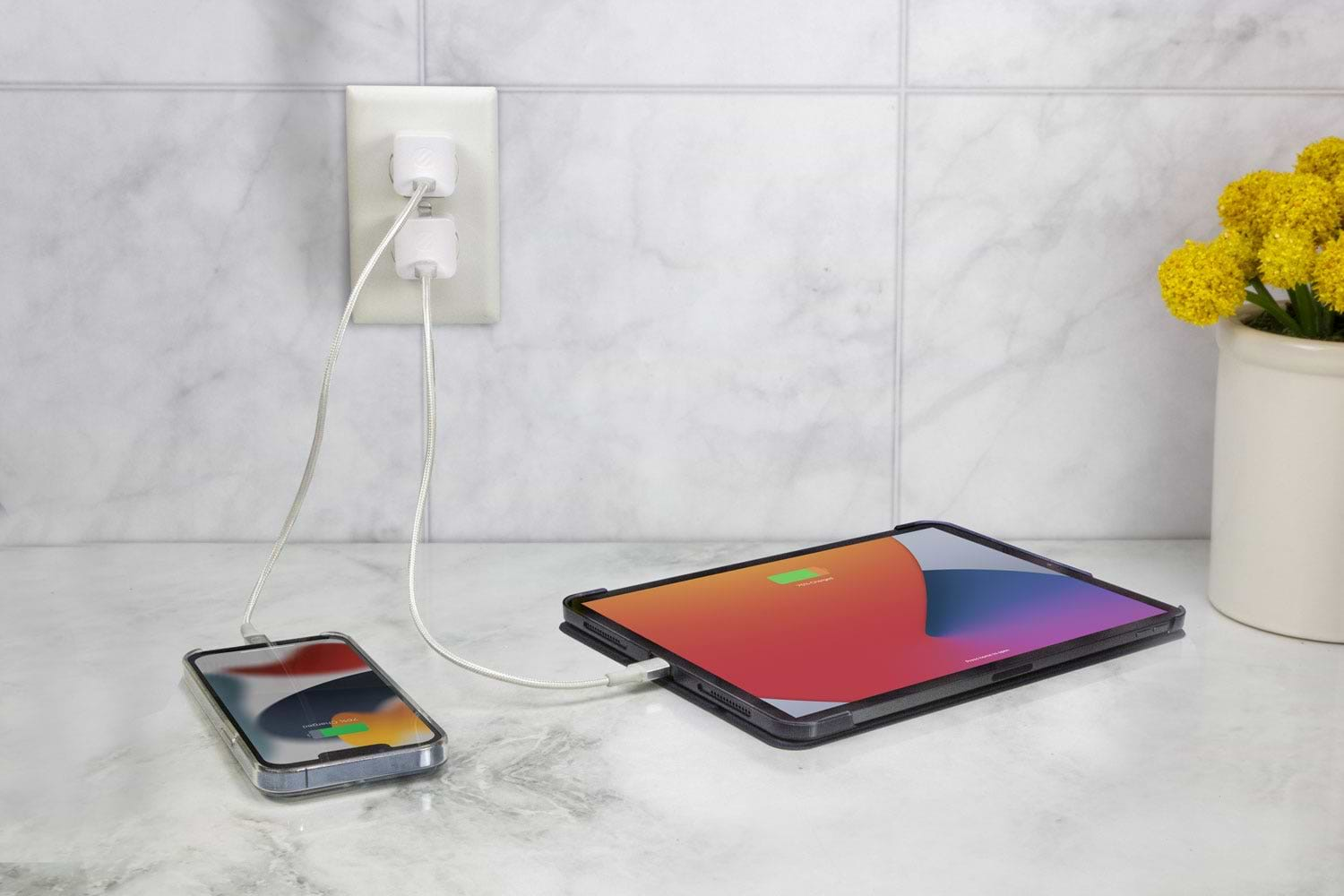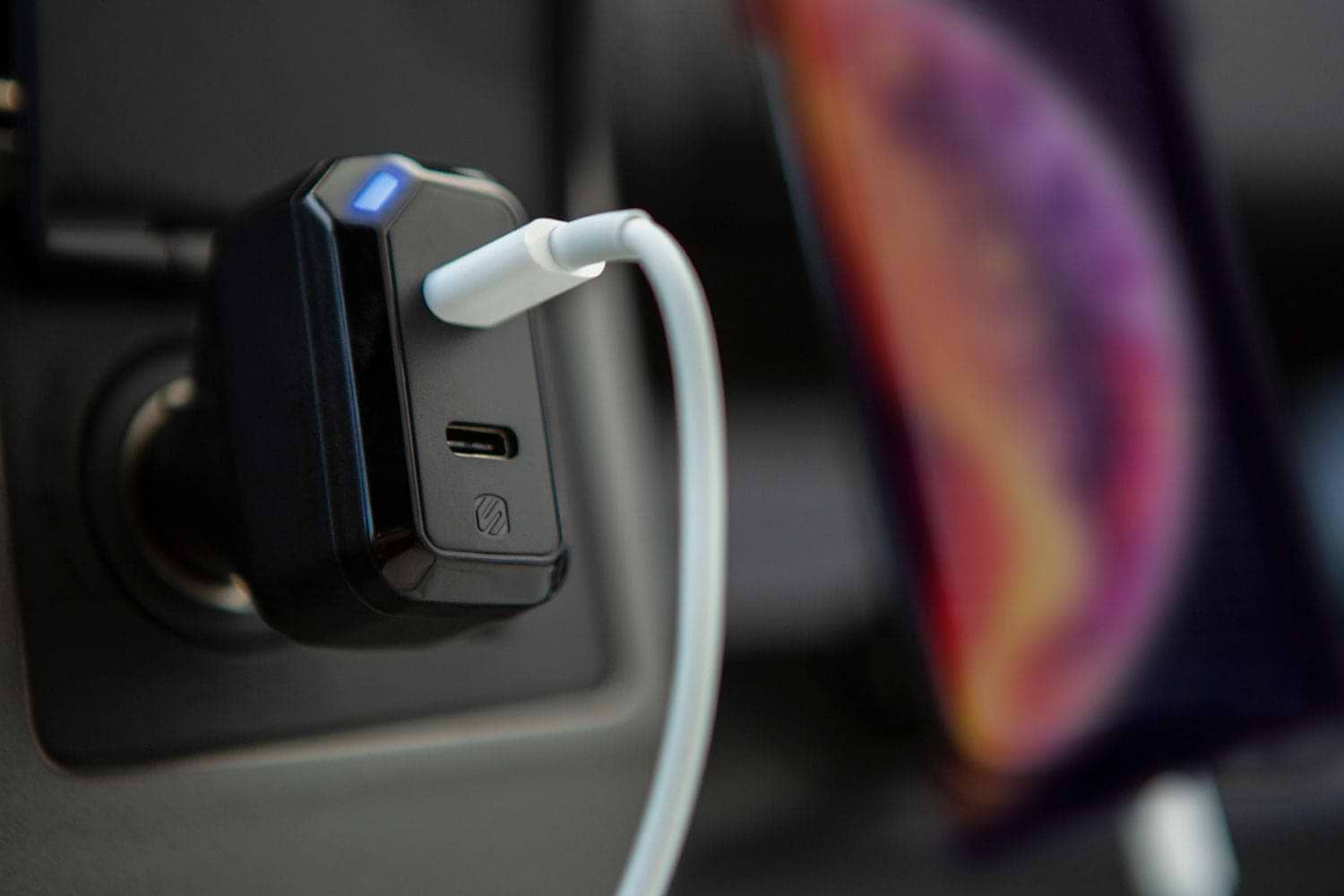Understanding Different Phone Charger Types

In today's fast-paced world, our smartphones have become essential tools for communication, entertainment, and productivity. And to keep these devices running smoothly, we rely on phone chargers. But have you ever wondered about the different types of phone chargers available?
In this article, we will explore the evolution of phone chargers, identify the various types, delve into the science behind their functionality, and provide tips on choosing the right charger for your phone.
So let's dive in and enhance our understanding of these indispensable accessories.
The Evolution of Phone Chargers
Over the years, phone chargers have undergone significant transformations to keep up with advancing technology. From the humble wall chargers to the revolutionary wireless chargers, let's take a brief look at their evolution.
Phone chargers have come a long way since the early days of mobile phones. In the beginning, wall chargers were the primary method of charging phones. These chargers were bulky and had limited compatibility, often requiring adapters for different phone models. It was a hassle to carry around multiple chargers or adapters just to charge your phone.
However, with advancements in technology and the rise of USB-based charging, wall chargers became more compact, efficient, and versatile. The introduction of USB chargers revolutionized the charging game. USB Type-A ports were commonly used at first, but as devices became smaller and slimmer, the industry embraced smaller connectors like Micro-USB and Mini-USB. These connectors allowed for faster data transfer and charging capabilities.
Today, USB Type-C, with its reversible design and increased power delivery capabilities, is the preferred choice for many modern smartphones. Its versatility and convenience have made it a popular choice among manufacturers and consumers alike.
From Wall Chargers to Wireless: A Brief History
The era of wall chargers began with traditional electrical outlets. Initially, chargers were bulky and had limited compatibility, often requiring adapters for different phone models. However, with advancements in technology and the rise of USB-based charging, wall chargers became more compact, efficient, and versatile.
Wireless charging, on the other hand, represents a revolutionary shift in charger design. It utilizes electromagnetic fields to transfer power to the device without the need for physical connections. Qi, an open wireless charging standard, has gained significant popularity, allowing compatibility across various smartphone brands.
With wireless charging, you no longer have to deal with tangled cables or worry about finding the right charger for your phone. Simply place your phone on a wireless charging pad or stand, and it will start charging automatically. This convenience has made wireless charging a sought-after feature in modern smartphones.
Wireless charging technology continues to evolve, with advancements in efficiency and charging speeds. Some wireless chargers now support fast charging, allowing you to charge your phone quickly and conveniently.
How Technology Has Shaped Phone Charging
Technology has played a crucial role in shaping phone charging methods. With each new phone model, we witness advancements that facilitate faster and more efficient charging.
One example of this is the introduction of USB chargers. Initially, USB Type-A ports were commonly used, but as devices became smaller and slimmer, the industry embraced smaller connectors like Micro-USB and Mini-USB. These connectors allowed for faster data transfer and charging capabilities.
As technology continues to advance, we can expect further improvements in phone charging. The future may bring even faster charging speeds, longer battery life, and more innovative charging methods.
In conclusion, the evolution of phone chargers has been driven by the need for convenience, compatibility, and efficiency. From the bulky wall chargers of the past to the sleek and wireless chargers of today, phone charging has come a long way. With each new advancement, we get closer to a future where charging our phones is seamless and effortless.
Identifying Different Phone Charger Types
Now that we have explored the evolution of phone chargers, let's dig deeper and identify the various charger types available in the market.
When it comes to charging our phones, we have come a long way from the days of bulky chargers with limited compatibility. Today, we have a plethora of options to choose from, each offering unique features and advantages.


USB Chargers: Micro, Mini, and Type-C
USB chargers are popular for their versatility and broad compatibility. The USB Type-A port is the standard for older devices, while Micro-USB and Mini-USB ports became prevalent in the early 2000s. These smaller connectors were commonly found on feature phones and early smartphones.
Micro-USB, with its compact size, quickly became the go-to choice for many manufacturers. It allowed for faster data transfer and charging compared to its predecessor, Mini-USB. Mini-USB, although larger in size, was still widely used in various electronic devices.
In recent years, the industry has embraced USB Type-C, a versatile and reversible connector that offers faster charging speeds and higher power delivery. With its widespread adoption, USB Type-C has become the go-to choice for many flagship smartphones. Its symmetrical design eliminates the frustration of trying to plug it in the right way, making it a user-friendly option.
Wireless Chargers: Inductive and Resonant
Wireless chargers represent a cable-free charging solution that offers convenience and minimal clutter. The two prominent wireless charging technologies are inductive charging and resonant charging.
Inductive charging relies on an electromagnetic field to transfer power from the charger to the device. It requires close proximity and proper alignment between the charger and the phone. This technology has gained popularity due to its simplicity and ease of use. Simply place your phone on the charging pad, and it starts charging wirelessly.
Resonant charging, on the other hand, allows for greater flexibility in terms of distance and alignment, making it more user-friendly. This technology uses resonant inductive coupling to transfer power. It allows for charging even when the phone is not in direct contact with the charging pad, providing more freedom and convenience.
Portable Chargers: Power Banks and Solar Chargers
For those on the go, portable chargers, also known as power banks, are lifesavers. These compact devices store electrical energy and deliver it to smartphones when an outlet is unavailable. Power banks are available in various capacities, allowing you to choose one that suits your needs.
With the increasing demand for sustainable and eco-friendly solutions, solar chargers have gained popularity. Harnessing the power of the sun, solar chargers convert sunlight into electrical energy, providing a sustainable charging option, especially in outdoor settings. These chargers are equipped with solar panels that capture sunlight and convert it into usable power, ensuring that your devices stay charged even when you are off the grid.
When it comes to choosing a portable charger, it is essential to consider factors such as capacity, portability, and compatibility with your devices. Whether you opt for a power bank or a solar charger, having a reliable portable charging solution ensures that you never run out of battery power when you need it the most.
The Science Behind Phone Chargers
While we may take phone chargers for granted, understanding the science behind their functionality can deepen our appreciation for these ingenious devices.
Phone chargers have become an essential part of our daily lives, ensuring that our devices stay powered up and ready to use. But have you ever wondered how these chargers actually work? Let's delve into the fascinating science behind phone chargers.
How USB Chargers Work
USB chargers utilize a standard known as Universal Serial Bus (USB) to transfer power. When you connect your phone to a USB charger, the charger supplies a specific voltage and amperage to the device, allowing it to charge. But how does this happen?
Inside the USB charger, there are intricate circuits that regulate the flow of electricity. These circuits ensure that the voltage and amperage supplied to your phone are within safe limits. They also prevent any power surges or fluctuations that could potentially damage your device.
USB ports supply direct current (DC) power, ensuring the charging process is safe and efficient. Direct current is the type of electricity that our devices use, so the charger converts the alternating current (AC) from the power outlet into DC before delivering it to your phone.
The Technology Behind Wireless Charging
Wireless charging has revolutionized the way we charge our devices. Instead of relying on cables, wireless charging allows us to simply place our phones on a charging pad or stand. But how does this magical technology work?
Wireless charging relies on electromagnetic induction for power transfer. The charger contains a coil that generates an alternating magnetic field, which induces an electric current in the coil inside the phone. This current is then converted into usable power to charge the battery.
It's fascinating to think that the charger and the phone communicate through magnetic fields, enabling the transfer of energy without any physical connection. This technology has made charging more convenient and eliminates the hassle of dealing with tangled cables.
The Power of Portable Chargers
Portable chargers, such as power banks, have become a lifesaver for those constantly on the move. These compact devices store electrical energy, allowing you to charge your phone or other devices anytime, anywhere. But how do they work?
Power banks typically use Lithium-ion batteries to store electrical energy. These batteries are lightweight and have a high energy density, making them perfect for portable chargers. When connected to a device, the power bank releases the stored energy, allowing for on-the-go charging.
But what if you're in a place with no access to electricity? That's where solar chargers come in. Solar chargers harness the power of the sun to charge your devices. They contain photovoltaic cells that convert solar energy into electrical energy. These cells absorb sunlight and generate an electric current, which is then used to charge the battery in the power bank.
Solar chargers are not only eco-friendly but also provide a sustainable solution for charging your devices when you're outdoors or in remote locations.
As you can see, phone chargers are not just simple accessories. They are the result of intricate engineering and scientific principles. Understanding the science behind phone chargers not only enhances our appreciation for these devices but also allows us to make informed choices when it comes to selecting the right charger for our needs.
Choosing the Right Charger for Your Phone
With numerous charger options available, choosing the right one for your phone can be overwhelming. However, by considering a few key factors, you can make an informed decision.
Compatibility Issues with Different Chargers
When selecting a charger, compatibility is crucial. Ensure that the charger supports your phone's charging port and voltage requirements. USB Type-C chargers have become more standardized and are compatible with a wide range of devices, making them a versatile choice.
Pros and Cons of Various Charger Types
Each charger type has its advantages and limitations. USB chargers offer convenience and compatibility, but charging speeds may vary. Wireless chargers provide cable-free convenience, but charging times can be slower. Portable chargers offer on-the-go charging but require periodic recharging themselves.
Safety Considerations When Choosing a Charger
It's crucial to prioritize safety when selecting a charger. Look for chargers that are certified by regulatory bodies such as the USB Implementers Forum (USB-IF) or Wireless Power Consortium (WPC). These certifications ensure adherence to safety standards and minimize the risk of overheating or electrical damage.
In conclusion, understanding the different phone charger types is essential to ensure efficient and safe charging for our smartphones. The evolution of charger technology, from wall chargers to wireless options, has given us more flexibility and convenience. By identifying the various charger types such as USB, wireless, and portable chargers, we can choose the one that best fits our needs. Additionally, delving into the science behind chargers helps us appreciate the intricate engineering that powers these devices.
Finally, considering compatibility, pros and cons, and safety when choosing a charger ensures optimal charging performance. So next time you plug in your phone, you'll have a deeper understanding of the charger that keeps your device powered and ready for action.